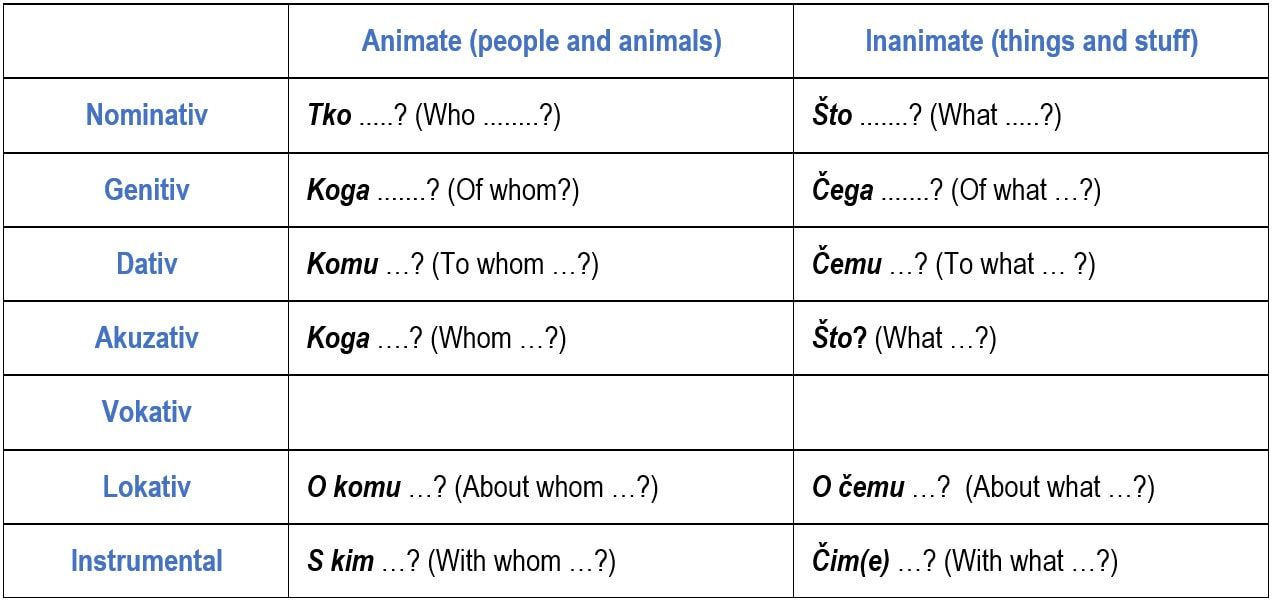Croatian grammar #005The declensions of ‘Tko?’ and ‘Što?’
From my first day of learning Croatian, I have been told about the importance of certain questions that can define the different cases of nouns and pronouns.
A table of these questions is presented in the Grammar reference section of this website (Questions that define the case of nouns) and reproduced here:
I have been confused about what this means, but my current teacher Mateja at SpeakCro has pointed out that these questions are not the only criteria that define the cases: after all, surely locative case is most characteristically defined by the question Gdje?
But, Aha! Blow me down (an Australianism), I have just realised that those on the left are the declensions, according to case, of the nominative question “Tko?” And those on the right are the declined forms of the question “Što?” Now I am coming to see how fundamental the words in this table are to any conversation, and particularly to every question that I ask. Strewth! (Guess where that comes from ….). Bear with me while I clarify my own understanding of the importance of the nominative questions “Tko?” and “Što”. Aha! When I use the nominative forms of these questions, the answer is also in the nominative case. Some examples, with sample answers are …….
Q. Tko je to? (Who is that?) Ans. To je Ivan.
Q. Tko dolaze? (Who is coming?) Ans. Marta dolaze. Q. Što je to? (What is that?) Ans. To je časa. Q. Što je plav? (What is blue?) Ans. Lopta je plava And now I see for the first time that the answer to my question directly replaces the words “Tko?” or “Što?” in the answer. For example, in the first answer, “Ivan” has replaced “Tko” in the question. Kužim! I’m so close to mastery of learning Croatian! :-) And what about in all the other cases (genitiv, dativ, akuzativ, lokativ, instrumental) – especially when they are used in more complex text? I have made up a short story in which there are answers to “Tko?” in all six cases (not vokativ):
Marinela je odlučila ići u Hrvatsku. Išla je sa sinom Zoranom u Zadar. U avionu, Zoran je sjedio pokraj velikog muškarca i je mislio o starom ocu koji nije mogao doći. Oni su posjetili Marinelinu mamu i Zoran je dao poklon bratiću Nenadu.
Can you recognise the six cases?
If we want to question (interrogate) somebody about who is does what, we need to ask with the appropriate form of “tko”, according to case. In the order that they appear in the text, here are the questions, with answers (also in forms appropriate to the case):
Nominativ: Q. Tko je odlučio ići u Hrvatsku? Ans. Marinela.
Instrumental: Q. S kim je išla Marinela? Ans. Sa sinom Zoranom. Genitiv: Q. Pokraj koga je sjedio Zoran? Ans. Pokraj velikog muškarca. Lokativ: Q. O komu je Zoran mislio u avionu? Ans. O starom ocu. Akuzativ: Q. Koga su posjetili? Ans. Marinelinu mamu. Dativ: Q. Komu je Zoran dao poklon? Ans. Bratiću Nenadu.
I now realise that when the pronoun “Tko” is used in this questioning way, it is called an interrogative pronoun (upitna zamenica).
Such was the information overload (for my little mind) before I came to Mateja that I didn’t realise that “tko”, and its case-dependent forms, can have a different role in sentences: when it is a so-called relational pronoun (odnosna zamenica). In another post I’ll talk about odnosne zamenice.
Of course, there is a corresponding set of interrogative pronouns which are the declensions of “Što?”
Nominative: Što je to? Genitive: Ispred čega je pas? Dative: Čemu služi? Accusative: Što vidiš? Locative: O čemu razgovarate? Instrumental: Čime si otvorio limenku?
Hočete li malo vježbe?
Here are some questions, with answers, about a situation. Can you describe the situation?
Q. Tko je išao u šetnju? Ans. Mirjana i Slavica.
Q. Iza koga su šetale? Ans. Iza stare žene. Q. Komu su dale malo vode? Ans. Staroj ženi. Q. Koga je pitala stara žena koliko je sati? Ans: Mirjanu i Slavicu. Q. O komu su razgovarale? Ans. O Branimiru i Tomislavu. Q. S kim sada žive Branimir i Tomislav? Ans. Sa svojom majkom. There is not a unique answer. Here is one possible description of the situation. Mirjana i Slavica su išle u šetnju. Šetale su iza stare žene. Dale su joj malo vode, i ona ih je pitala koliko je sati. Mirjana i Slavica su razgovarale o Branimiru i Tomislavu koji sada žive sa svojom majkom.
And just in case ….
Mirjana i Slavica [nominativ] su išle u šetnju. Šetale su iza stare žene [genitiv]. Dale su joj [dativ] malo vode, i ona ih [akuzativ] je pitala koliko je sati. Mirjana i Slavica su razgovarale o Branimiru i Tomislavu [lokativ] koji sada žive sa svojom majkom [instrumental].
Getting around
You can browse or search this website in the following ways:
AHA! Learning Croatian with Bob
Correspondence: [email protected]
1 Comment
Just a small comment. Likely kome is more common than komu, you will mostly read and hear o kome etc.
Reply
Leave a Reply. |
